Abstract
Animals with lateral hypothalamic lesions lost significantly more weight in the 18 h following this lesion than did sham-operated animals or rats with cerebral cortical lesions deprived of food for the same time period. In the acutely fasted sham-operated animals the turnover of norepinephrine in interscapular brown adipose tissue, heart, and pancreas was slowed but in fasted rats with lateral hypothalamic lesions norepinephrine turnover rates were three- to ninefold faster in all three organs. Exposure to the cold (4 degrees C) significantly increased norepinephrine turnover in the interscapular brown adipose tissue, heart, and pancreas of fasted sham-operated rats, but did not further increase the rate of turnover in lateral hypothalamic-lesioned rats. Rats with lesions in the cerebral cortex responded in a fashion similar to that of the sham-operated animals. Gastric erosions and microhemorrhagic gastric mucosa were observed in five of six acutely fasted rats with lateral hypothalamic lesions whereas all sham-operated rats had a normal appearance of the stomach lining. Animals with lateral hypothalamic lesions made 3 wk earlier also showed an increased rate of norepinephrine turnover in the interscapular brown adipose tissue, heart, and pancreas following an 18 h fast. Rats with bilateral lesions in the paraventricular region of the hypothalamus, however, responded similarly to sham-operated animals with a reduction in the turnover in norepinephrine with fasting and an increase in norepinephrine turnover rate after cold exposure even with fasting. These data suggest that lateral hypothalamic lesions produce an acute increase in turnover of norepinephrine, and that this increased turnover persists for up to 3 wk.
Full text
PDF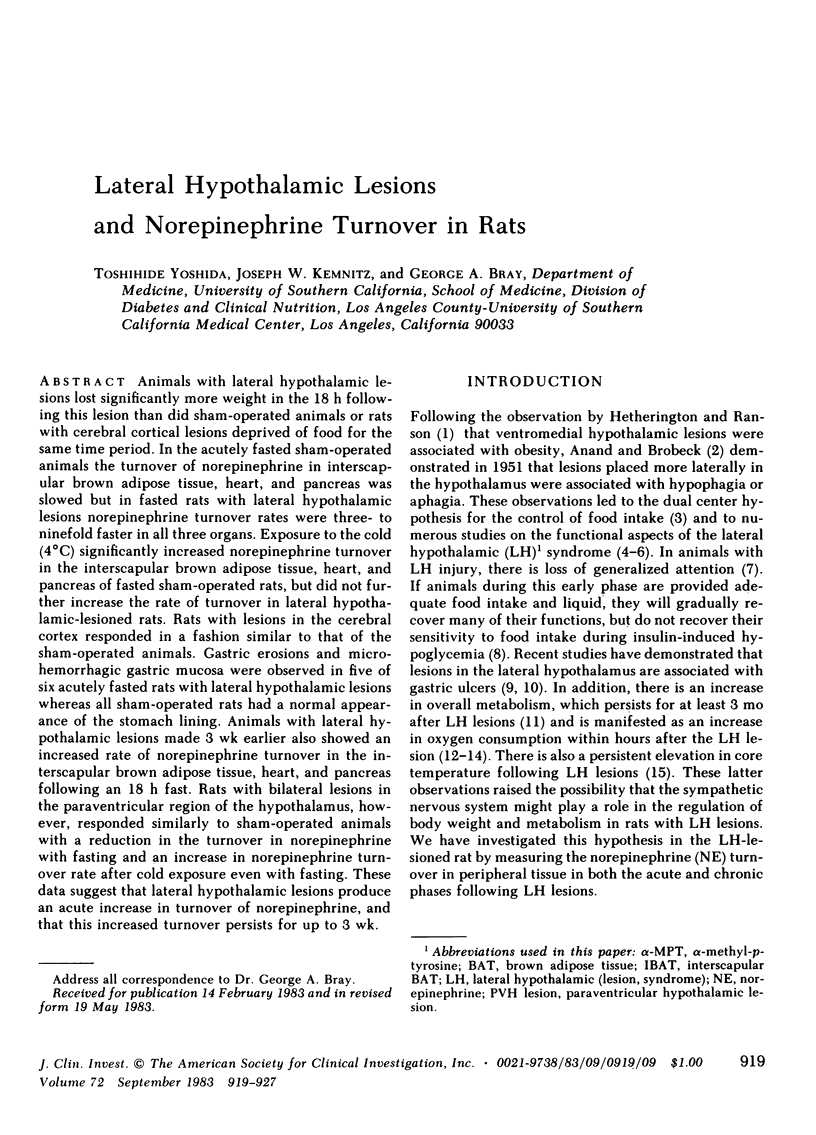
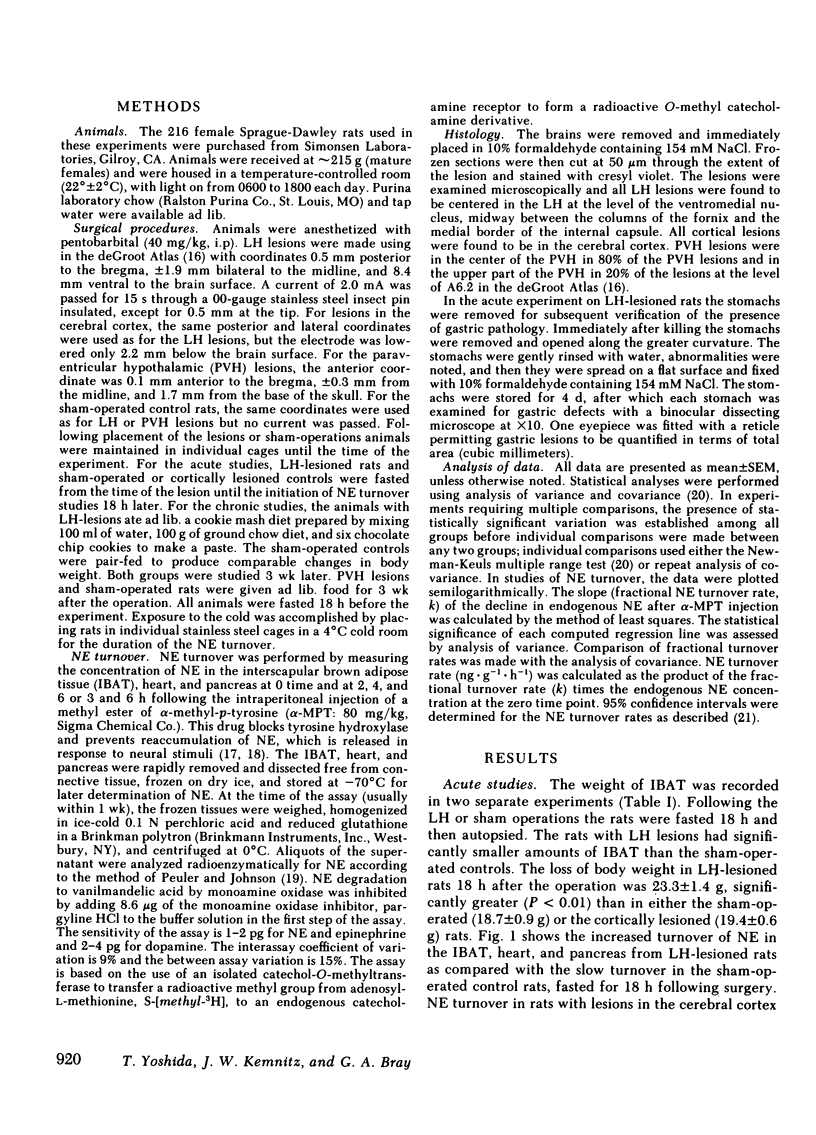

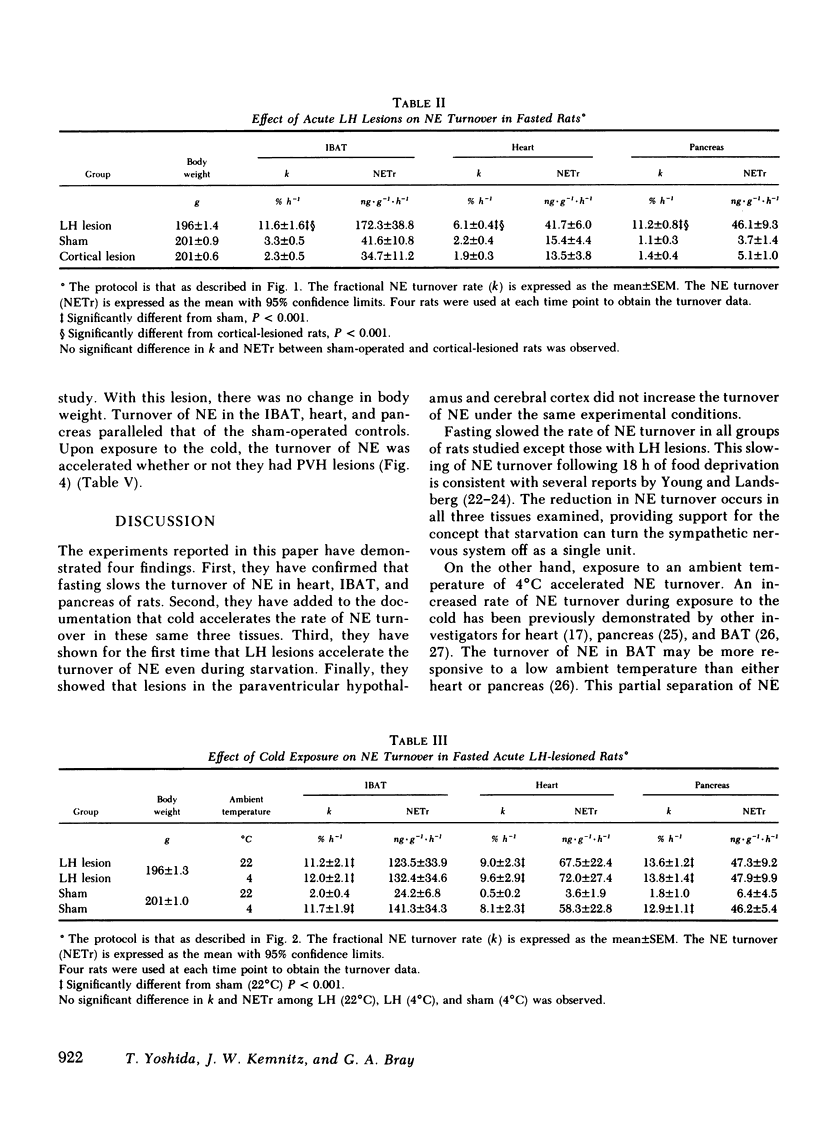
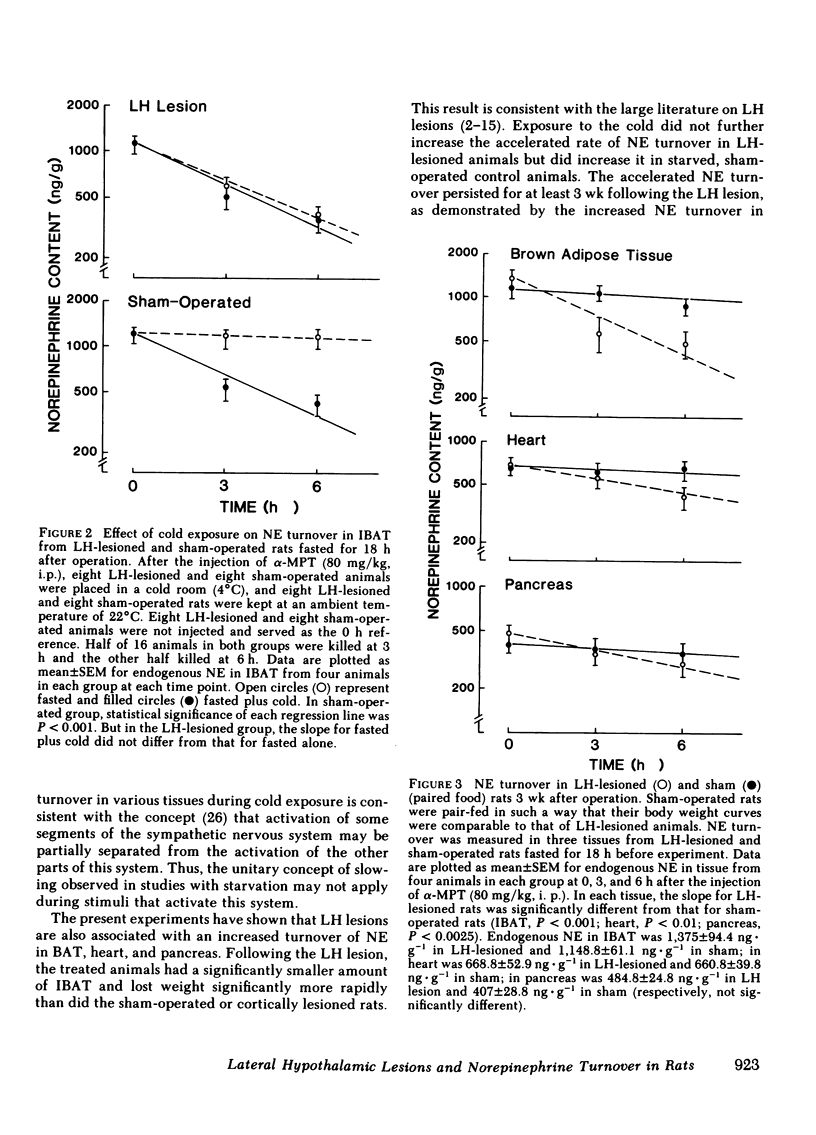

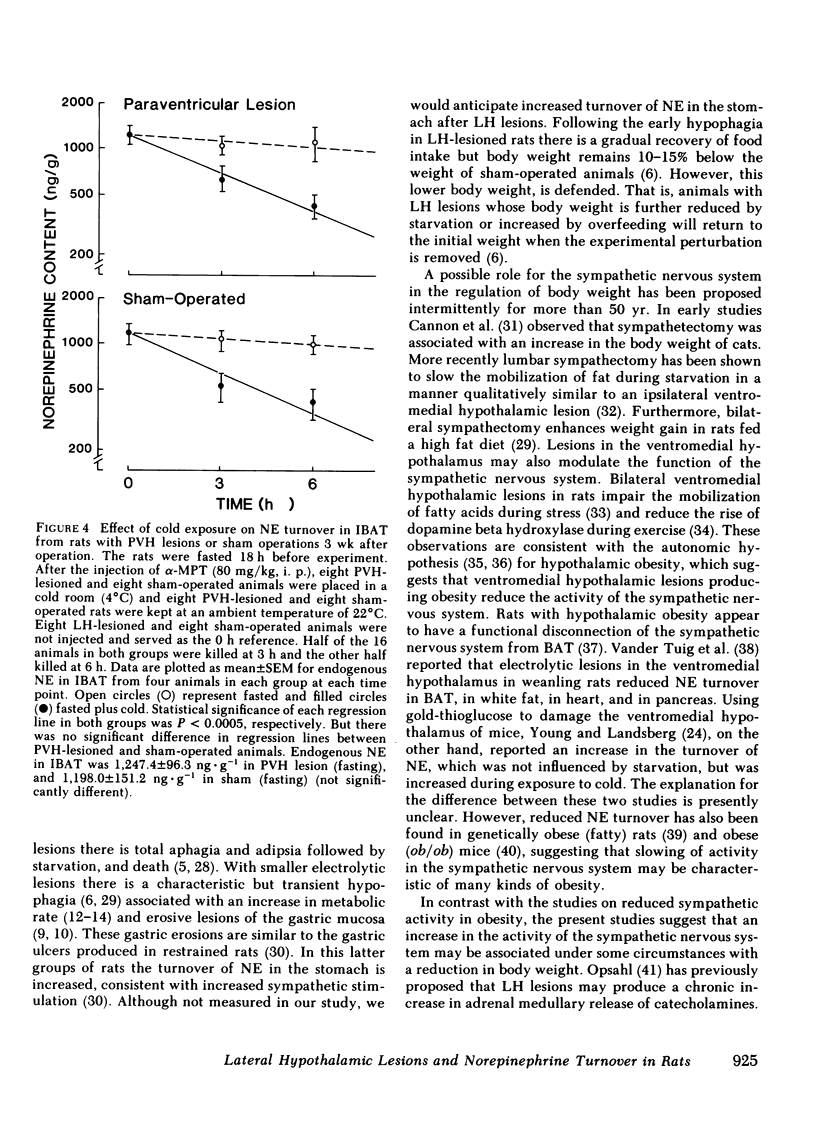
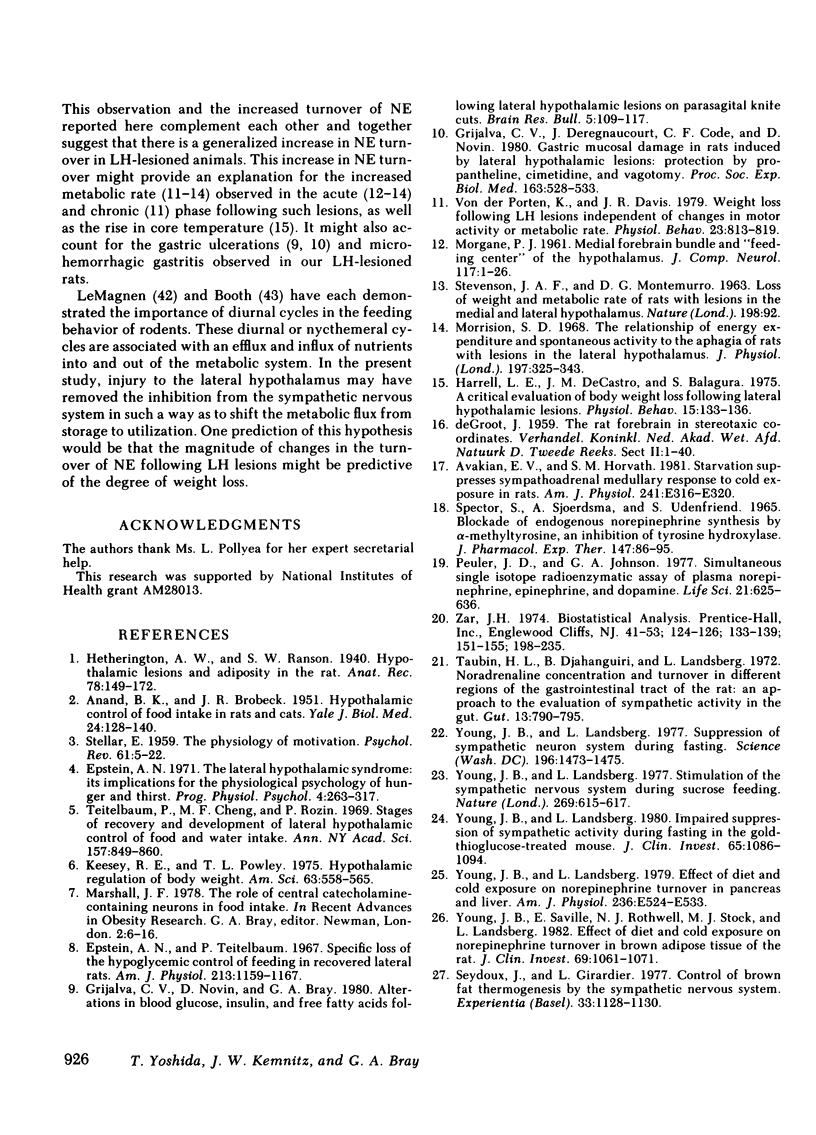

Selected References
These references are in PubMed. This may not be the complete list of references from this article.
- ANAND B. K., BROBECK J. R. Hypothalamic control of food intake in rats and cats. Yale J Biol Med. 1951 Nov;24(2):123–140. [PMC free article] [PubMed] [Google Scholar]
- Avakian E. V., Horvath S. M. Starvation suppresses sympathoadrenal medullary response to cold exposure in rats. Am J Physiol. 1981 Oct;241(4):E316–E320. doi: 10.1152/ajpendo.1981.241.4.E316. [DOI] [PubMed] [Google Scholar]
- Bray G. A., Inoue S., Nishizawa Y. Hypothalamic obesity. The autonomic hypothesis and the lateral hypothalamus. Diabetologia. 1981 Mar;20 (Suppl):366–377. [PubMed] [Google Scholar]
- Bray G. A., York D. A. Hypothalamic and genetic obesity in experimental animals: an autonomic and endocrine hypothesis. Physiol Rev. 1979 Jul;59(3):719–809. doi: 10.1152/physrev.1979.59.3.719. [DOI] [PubMed] [Google Scholar]
- Djahanguiri B., Taubin H. L., Landsberg L. Increased sympathetic activity in the pathogenesis of restraint ulcer in rats. J Pharmacol Exp Ther. 1973 Jan;184(1):163–168. [PubMed] [Google Scholar]
- Epstein A. N., Teitelbaum P. Specific loss of the hypoglycemic control of feeding in recovered lateral rats. Am J Physiol. 1967 Nov;213(5):1159–1167. doi: 10.1152/ajplegacy.1967.213.5.1159. [DOI] [PubMed] [Google Scholar]
- Grijalva C. V., Deregnaucourt J., Code C. F., Novin D. Gastric mucosal damage in rats induced by lateral hypothalamic lesions: protection by propantheline, cimetidine, and vagotomy. Proc Soc Exp Biol Med. 1980 Apr;163(4):528–533. doi: 10.3181/00379727-163-40809. [DOI] [PubMed] [Google Scholar]
- Harrell L. E., Decastro J. M., Balagura S. A critical evaluation of body weight loss following lateral hypothalamic lesions. Physiol Behav. 1975 Jul;15(1):133–136. doi: 10.1016/0031-9384(75)90292-9. [DOI] [PubMed] [Google Scholar]
- Inoue S., Bray G. A. An autonomic hypothesis for hypothalamic obesity. Life Sci. 1979 Aug 13;25(7):561–566. doi: 10.1016/0024-3205(79)90549-6. [DOI] [PubMed] [Google Scholar]
- Keesey R. E., Powley T. L. Hypothalamic regulation of body weight. Am Sci. 1975 Sep-Oct;63(5):558–565. [PubMed] [Google Scholar]
- Knehans A. W., Romsos D. R. Reduced norepinephrine turnover in brown adipose tissue of ob/ob mice. Am J Physiol. 1982 Apr;242(4):E253–E261. doi: 10.1152/ajpendo.1982.242.4.E253. [DOI] [PubMed] [Google Scholar]
- MORGANE P. J. Medial forebrain bundle and "feeding centers" of the hypothalamus. J Comp Neurol. 1961 Aug;117:1–25. doi: 10.1002/cne.901170102. [DOI] [PubMed] [Google Scholar]
- Nishizawa Y., Bray G. A. Ventromedial hypothalamic lesions and the mobilization of fatty acids. J Clin Invest. 1978 Mar;61(3):714–721. doi: 10.1172/JCI108984. [DOI] [PMC free article] [PubMed] [Google Scholar]
- Opsahl C. A. Sympathetic nervous system involvement in the lateral hypothalamic lesion syndrome. Am J Physiol. 1977 Mar;232(3):R128–R136. doi: 10.1152/ajpregu.1977.232.3.R128. [DOI] [PubMed] [Google Scholar]
- Peuler J. D., Johnson G. A. Simultaneous single isotope radioenzymatic assay of plasma norepinephrine, epinephrine and dopamine. Life Sci. 1977 Sep 1;21(5):625–636. doi: 10.1016/0024-3205(77)90070-4. [DOI] [PubMed] [Google Scholar]
- SPECTOR S., SJOERDSMA A., UDENFRIEND S. BLOCKADE OF ENDOGENOUS NOREPINEPHRINE SYNTHESIS BY ALPHA-METHYL-TYROSINE, AN INHIBITOR OF TYROSINE HYDROXYLASE. J Pharmacol Exp Ther. 1965 Jan;147:86–95. [PubMed] [Google Scholar]
- STELLAR E. The physiology of motivation. Psychol Rev. 1954 Jan;61(1):5–22. doi: 10.1037/h0060347. [DOI] [PubMed] [Google Scholar]
- Seydoux J., Girardier L. Control of brown fat thermogenesis by the sympathetic nervous system. Experientia. 1977 Sep 15;33(9):1128–1130. doi: 10.1007/BF01922280. [DOI] [PubMed] [Google Scholar]
- Taubin H. L., Djahanguiri B., Landsberg L. Noradrenaline concentration and turnover in different regions of the gastrointestinal tract of the rat: an approach to the evaluation of sympathetic activity in the gut. Gut. 1972 Oct;13(10):790–795. doi: 10.1136/gut.13.10.790. [DOI] [PMC free article] [PubMed] [Google Scholar]
- Teitelbaum P., Cheng M. F., Rozin P. Stages of recovery and development of lateral hypothalamic control of food and water intake. Ann N Y Acad Sci. 1969 May 15;157(2):849–860. doi: 10.1111/j.1749-6632.1969.tb12923.x. [DOI] [PubMed] [Google Scholar]
- Vander Tuig J. G., Knehans A. W., Romsos D. R. Reduced sympathetic nervous system activity in rats with ventromedial hypothalamic lesions. Life Sci. 1982 Mar 15;30(11):913–920. doi: 10.1016/0024-3205(82)90619-1. [DOI] [PubMed] [Google Scholar]
- Von Der Porten K., Davis J. R. Weight loss following LH lesions independent of changes in motor activity or metabolic rate. Physiol Behav. 1979 Nov;23(5):813–819. doi: 10.1016/0031-9384(79)90183-5. [DOI] [PubMed] [Google Scholar]
- Young J. B., Landsberg L. Effect of diet and cold exposure on norepinephrine turnover in pancreas and liver. Am J Physiol. 1979 May;236(5):E524–E533. doi: 10.1152/ajpendo.1979.236.5.E524. [DOI] [PubMed] [Google Scholar]
- Young J. B., Landsberg L. Impaired suppression of sympathetic activity during fasting in the gold thioglucose-treated mouse. J Clin Invest. 1980 May;65(5):1086–1094. doi: 10.1172/JCI109761. [DOI] [PMC free article] [PubMed] [Google Scholar]
- Young J. B., Landsberg L. Stimulation of the sympathetic nervous system during sucrose feeding. Nature. 1977 Oct 13;269(5629):615–617. doi: 10.1038/269615a0. [DOI] [PubMed] [Google Scholar]
- Young J. B., Landsberg L. Suppression of sympathetic nervous system during fasting. Science. 1977 Jun 24;196(4297):1473–1475. doi: 10.1126/science.867049. [DOI] [PubMed] [Google Scholar]
- Young J. B., Saville E., Rothwell N. J., Stock M. J., Landsberg L. Effect of diet and cold exposure on norepinephrine turnover in brown adipose tissue of the rat. J Clin Invest. 1982 May;69(5):1061–1071. doi: 10.1172/JCI110541. [DOI] [PMC free article] [PubMed] [Google Scholar]


